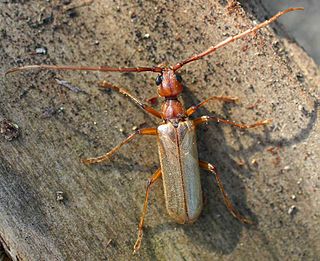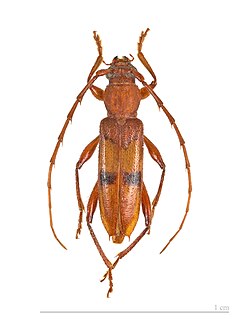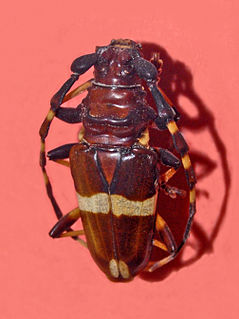
The longhorn beetles (Cerambycidae), also known as long-horned or longicorns, are a large family of beetles, with over 35,000 species described, slightly more than half from the Eastern Hemisphere. Most species are characterized by extremely long antennae, which are often as long as or longer than the beetle's body. In various members of the family, however, the antennae are quite short and such species can be difficult to distinguish from related beetle families such as the Chrysomelidae. The scientific name of this beetle family goes back to a figure from Greek mythology: after an argument with nymphs, the shepherd Cerambus was transformed into a large beetle with horns.

Lamiinae, commonly called flat-faced longhorns, are a subfamily of the longhorn beetle family (Cerambycidae). The subfamily includes over 750 genera, rivaled in diversity within the family only by the subfamily Cerambycinae.

The Disteniidae are a small family of beetles in the superfamily Chrysomeloidea, traditionally treated as a group within the Cerambycidae.

The Vesperidae are a small family of beetles, normally classified within the family Cerambycidae, of heterogeneous aspect but all characterised by larval stages related to roots of herbaceous plants or trees

Euplagia is a genus of tiger moths in the family Erebidae. The genus was erected by Jacob Hübner in 1820.

Stephan von Breuning was an Austrian entomologist who specialised in the study of beetles (Coleopterology), particularly within the longhorn family (Cerambycidae).

Elaphidiini is a tribe of beetles in the subfamily Cerambycinae, containing the following genera:

Anelaphus is a genus of beetles in the family Cerambycidae, containing the following species:
Gnomidolon is a genus of beetles in the family Cerambycidae, containing the following species:

Hexoplon is a genus of beetles in the family Cerambycidae, containing the following species:

Stenygra is a genus of beetles in the family Cerambycidae, containing the following species:
Compsibidion is a genus of beetles in the family Cerambycidae, containing the following species:
Cycnidolon is a genus of beetles in the family Cerambycidae, containing the following species:

Trachyderini is a tribe of long-horned beetles in the family Cerambycidae. There are at least 140 genera and 650 described species in Trachyderini.
Seabraellus is a genus of beetles in the family Cerambycidae, containing the following species:

Trachyderes is a genus of beetles in the family Cerambycidae, containing the following species:
Nyssodrysternum is a genus of beetles in the family Cerambycidae, containing the following species:
Aerenicini is a tribe of longhorn beetles of the subfamily Lamiinae.
Antodice is a genus of beetles in the family Cerambycidae, containing the following species:
Recchia is a genus of beetles in the family Cerambycidae, containing the following species:











